Audit Concepts: Definition, Application, and Case Studies
VerifiedAdded on 2021/04/24
|12
|3679
|68
Report
AI Summary
This report, titled "Audit Concepts Report," provides a comprehensive overview of key audit principles, focusing on the definition and application of materiality. It explores the concept of materiality as defined by the International Accounting Standards Committee, differentiating between materiality by nature, value, and context, and detailing common benchmarks used for its computation. The report delves into the techniques of materiality application as per ISA 450, including accumulating and categorizing misstatements and evaluating their materiality. Furthermore, it presents and analyzes several case studies, such as AB Cable Incorporation, Rocky Mountain Electric, Welco Company, and Fred Stern and Company, to illustrate the risks faced by auditors due to material misstatements and potential fraud. Finally, the report concludes with recommendations for auditors to mitigate risks and ensure the fairness and accountability of financial statements, emphasizing the importance of detecting material misstatements and maintaining a true and fair view.
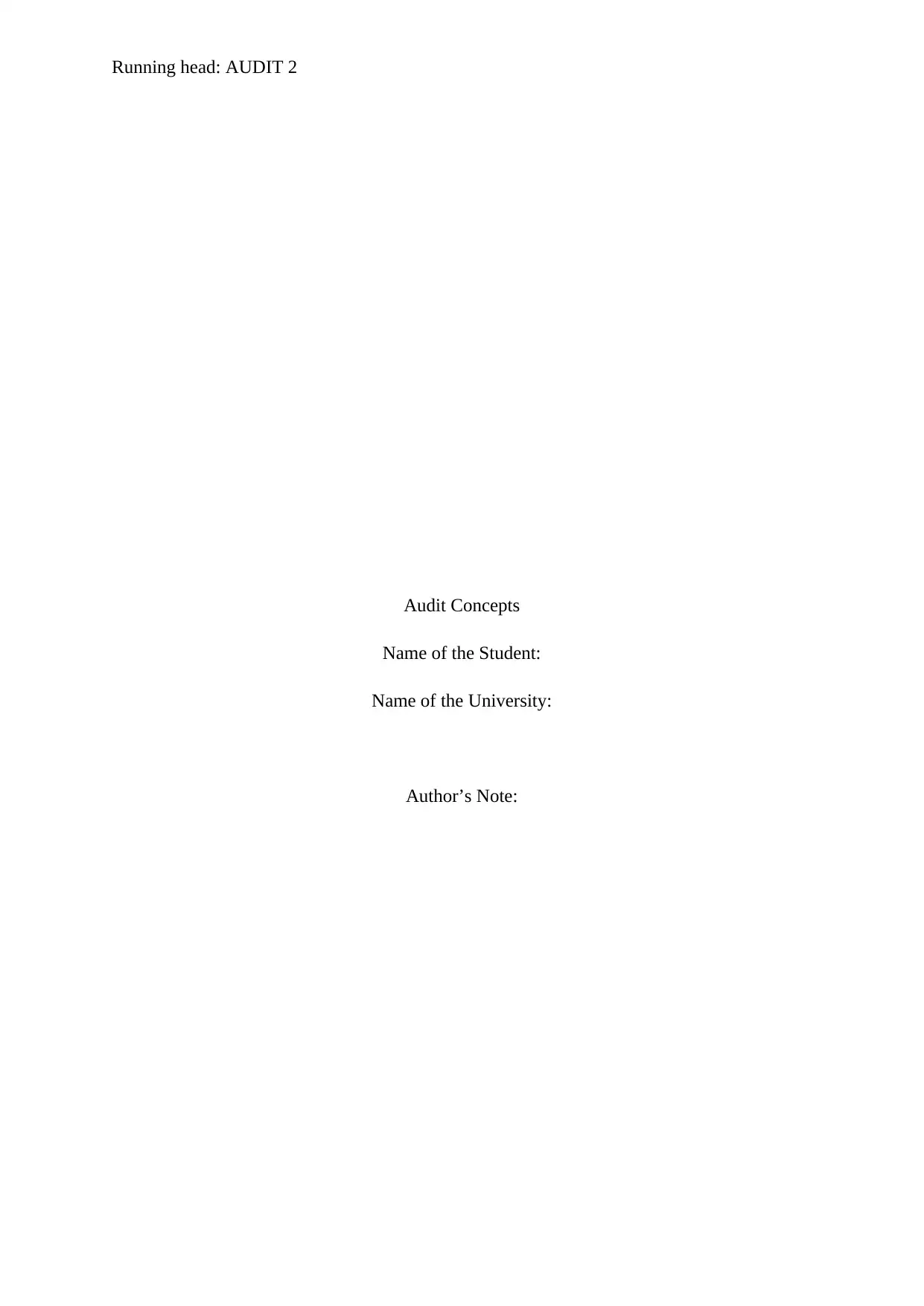
Running head: AUDIT 2
Audit Concepts
Name of the Student:
Name of the University:
Author’s Note:
Audit Concepts
Name of the Student:
Name of the University:
Author’s Note:
Paraphrase This Document
Need a fresh take? Get an instant paraphrase of this document with our AI Paraphraser
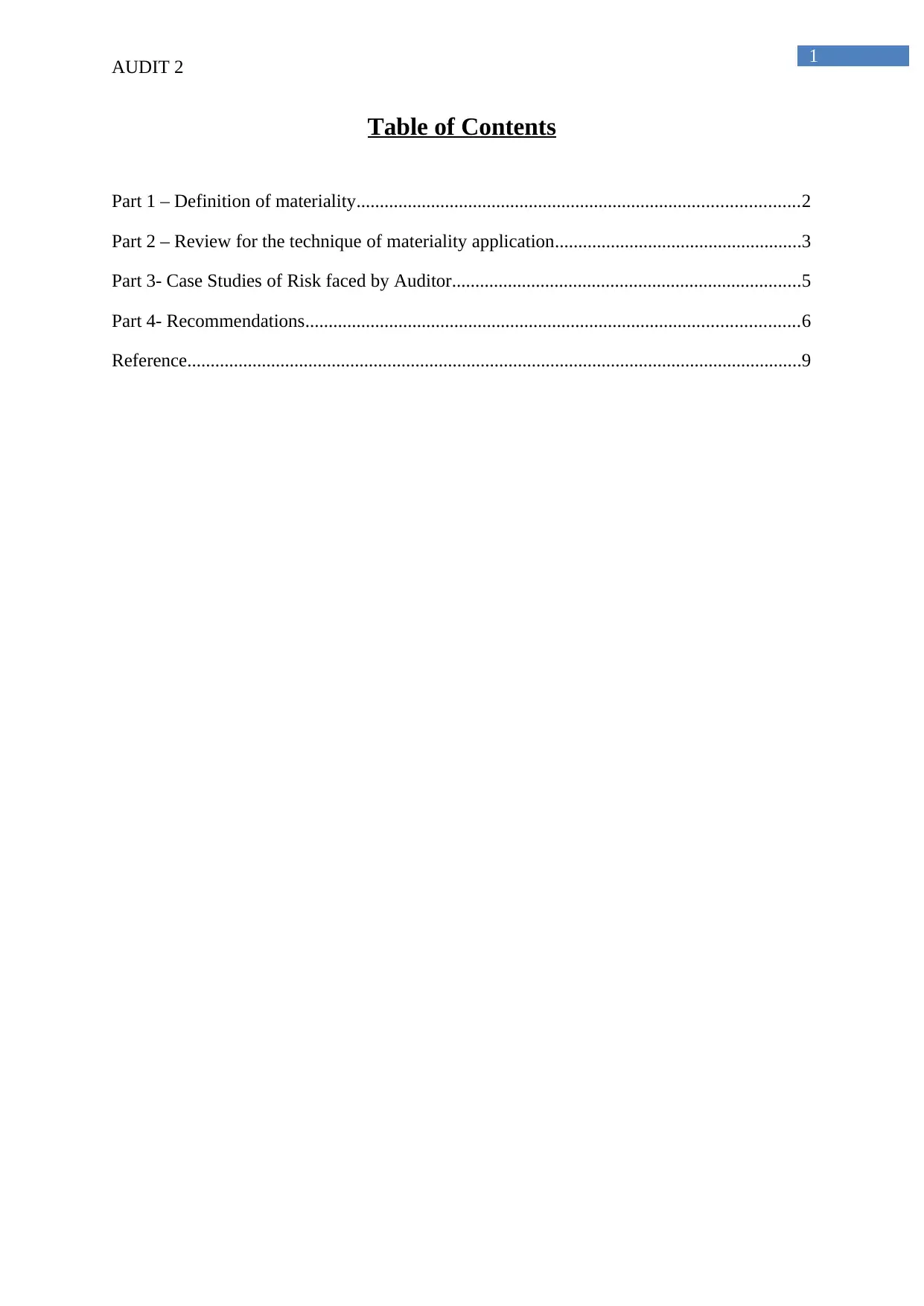
1
AUDIT 2
Table of Contents
Part 1 – Definition of materiality...............................................................................................2
Part 2 – Review for the technique of materiality application.....................................................3
Part 3- Case Studies of Risk faced by Auditor...........................................................................5
Part 4- Recommendations..........................................................................................................6
Reference....................................................................................................................................9
AUDIT 2
Table of Contents
Part 1 – Definition of materiality...............................................................................................2
Part 2 – Review for the technique of materiality application.....................................................3
Part 3- Case Studies of Risk faced by Auditor...........................................................................5
Part 4- Recommendations..........................................................................................................6
Reference....................................................................................................................................9
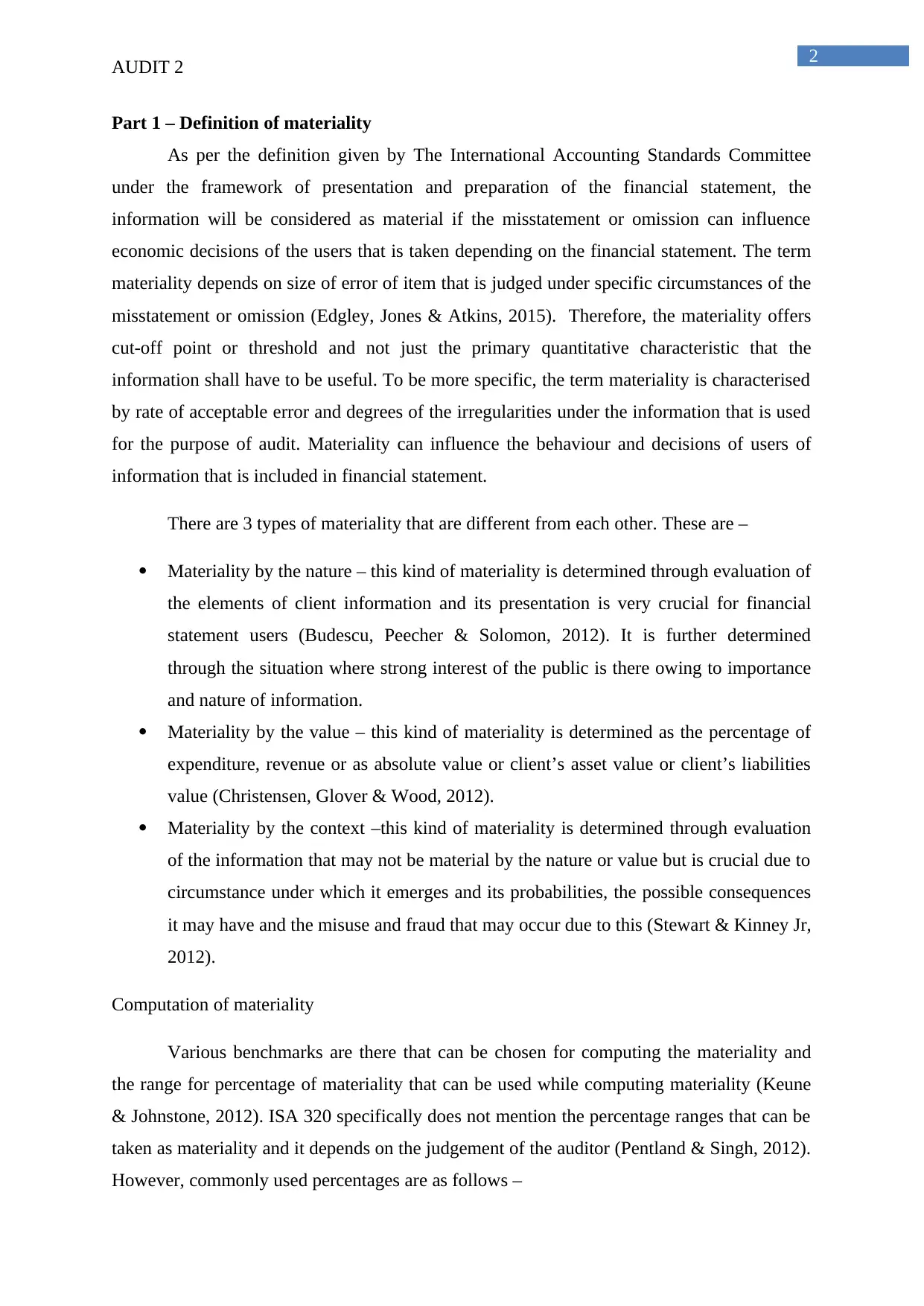
2
AUDIT 2
Part 1 – Definition of materiality
As per the definition given by The International Accounting Standards Committee
under the framework of presentation and preparation of the financial statement, the
information will be considered as material if the misstatement or omission can influence
economic decisions of the users that is taken depending on the financial statement. The term
materiality depends on size of error of item that is judged under specific circumstances of the
misstatement or omission (Edgley, Jones & Atkins, 2015). Therefore, the materiality offers
cut-off point or threshold and not just the primary quantitative characteristic that the
information shall have to be useful. To be more specific, the term materiality is characterised
by rate of acceptable error and degrees of the irregularities under the information that is used
for the purpose of audit. Materiality can influence the behaviour and decisions of users of
information that is included in financial statement.
There are 3 types of materiality that are different from each other. These are –
Materiality by the nature – this kind of materiality is determined through evaluation of
the elements of client information and its presentation is very crucial for financial
statement users (Budescu, Peecher & Solomon, 2012). It is further determined
through the situation where strong interest of the public is there owing to importance
and nature of information.
Materiality by the value – this kind of materiality is determined as the percentage of
expenditure, revenue or as absolute value or client’s asset value or client’s liabilities
value (Christensen, Glover & Wood, 2012).
Materiality by the context –this kind of materiality is determined through evaluation
of the information that may not be material by the nature or value but is crucial due to
circumstance under which it emerges and its probabilities, the possible consequences
it may have and the misuse and fraud that may occur due to this (Stewart & Kinney Jr,
2012).
Computation of materiality
Various benchmarks are there that can be chosen for computing the materiality and
the range for percentage of materiality that can be used while computing materiality (Keune
& Johnstone, 2012). ISA 320 specifically does not mention the percentage ranges that can be
taken as materiality and it depends on the judgement of the auditor (Pentland & Singh, 2012).
However, commonly used percentages are as follows –
AUDIT 2
Part 1 – Definition of materiality
As per the definition given by The International Accounting Standards Committee
under the framework of presentation and preparation of the financial statement, the
information will be considered as material if the misstatement or omission can influence
economic decisions of the users that is taken depending on the financial statement. The term
materiality depends on size of error of item that is judged under specific circumstances of the
misstatement or omission (Edgley, Jones & Atkins, 2015). Therefore, the materiality offers
cut-off point or threshold and not just the primary quantitative characteristic that the
information shall have to be useful. To be more specific, the term materiality is characterised
by rate of acceptable error and degrees of the irregularities under the information that is used
for the purpose of audit. Materiality can influence the behaviour and decisions of users of
information that is included in financial statement.
There are 3 types of materiality that are different from each other. These are –
Materiality by the nature – this kind of materiality is determined through evaluation of
the elements of client information and its presentation is very crucial for financial
statement users (Budescu, Peecher & Solomon, 2012). It is further determined
through the situation where strong interest of the public is there owing to importance
and nature of information.
Materiality by the value – this kind of materiality is determined as the percentage of
expenditure, revenue or as absolute value or client’s asset value or client’s liabilities
value (Christensen, Glover & Wood, 2012).
Materiality by the context –this kind of materiality is determined through evaluation
of the information that may not be material by the nature or value but is crucial due to
circumstance under which it emerges and its probabilities, the possible consequences
it may have and the misuse and fraud that may occur due to this (Stewart & Kinney Jr,
2012).
Computation of materiality
Various benchmarks are there that can be chosen for computing the materiality and
the range for percentage of materiality that can be used while computing materiality (Keune
& Johnstone, 2012). ISA 320 specifically does not mention the percentage ranges that can be
taken as materiality and it depends on the judgement of the auditor (Pentland & Singh, 2012).
However, commonly used percentages are as follows –
⊘ This is a preview!⊘
Do you want full access?
Subscribe today to unlock all pages.

Trusted by 1+ million students worldwide
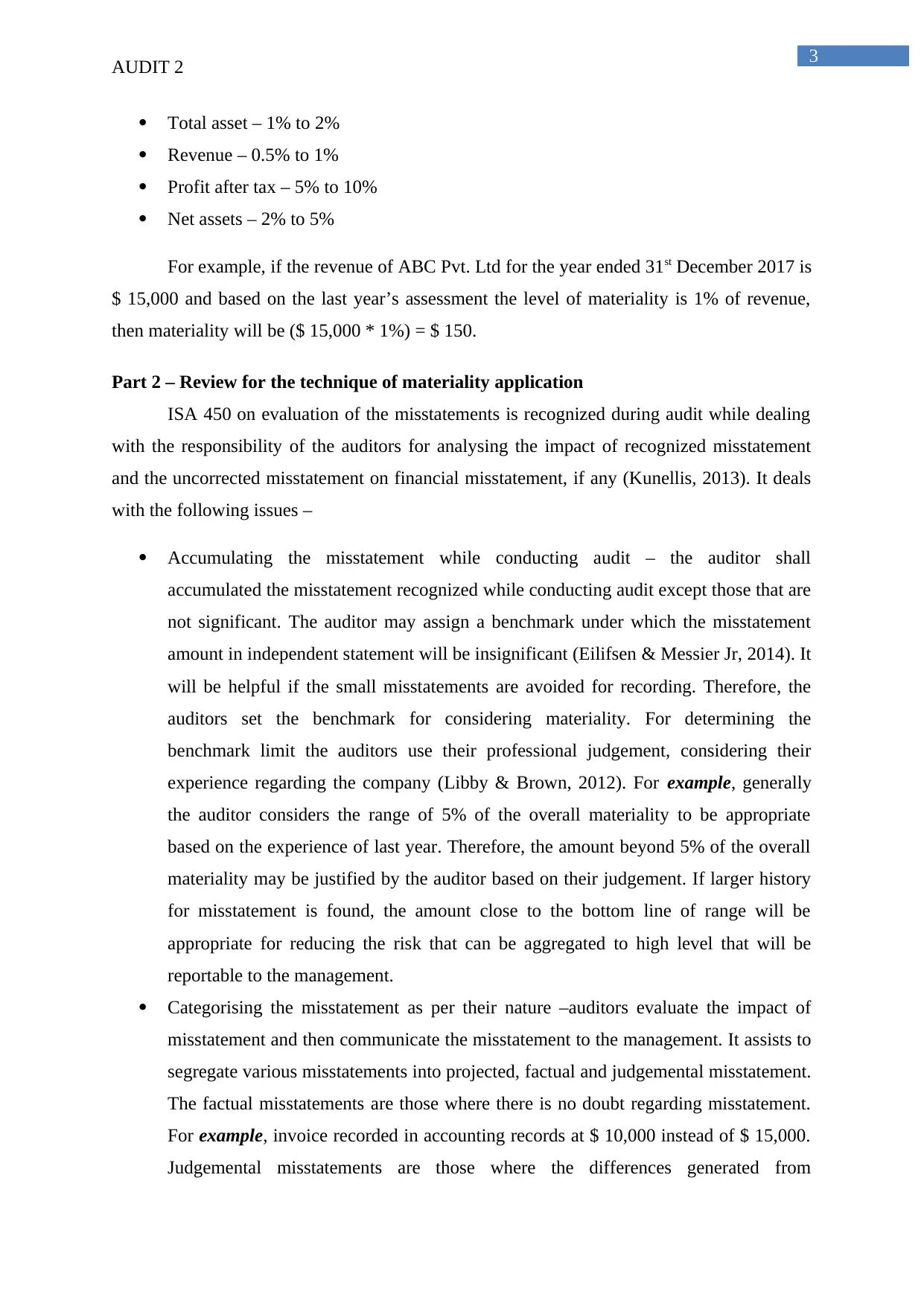
3
AUDIT 2
Total asset – 1% to 2%
Revenue – 0.5% to 1%
Profit after tax – 5% to 10%
Net assets – 2% to 5%
For example, if the revenue of ABC Pvt. Ltd for the year ended 31st December 2017 is
$ 15,000 and based on the last year’s assessment the level of materiality is 1% of revenue,
then materiality will be ($ 15,000 * 1%) = $ 150.
Part 2 – Review for the technique of materiality application
ISA 450 on evaluation of the misstatements is recognized during audit while dealing
with the responsibility of the auditors for analysing the impact of recognized misstatement
and the uncorrected misstatement on financial misstatement, if any (Kunellis, 2013). It deals
with the following issues –
Accumulating the misstatement while conducting audit – the auditor shall
accumulated the misstatement recognized while conducting audit except those that are
not significant. The auditor may assign a benchmark under which the misstatement
amount in independent statement will be insignificant (Eilifsen & Messier Jr, 2014). It
will be helpful if the small misstatements are avoided for recording. Therefore, the
auditors set the benchmark for considering materiality. For determining the
benchmark limit the auditors use their professional judgement, considering their
experience regarding the company (Libby & Brown, 2012). For example, generally
the auditor considers the range of 5% of the overall materiality to be appropriate
based on the experience of last year. Therefore, the amount beyond 5% of the overall
materiality may be justified by the auditor based on their judgement. If larger history
for misstatement is found, the amount close to the bottom line of range will be
appropriate for reducing the risk that can be aggregated to high level that will be
reportable to the management.
Categorising the misstatement as per their nature –auditors evaluate the impact of
misstatement and then communicate the misstatement to the management. It assists to
segregate various misstatements into projected, factual and judgemental misstatement.
The factual misstatements are those where there is no doubt regarding misstatement.
For example, invoice recorded in accounting records at $ 10,000 instead of $ 15,000.
Judgemental misstatements are those where the differences generated from
AUDIT 2
Total asset – 1% to 2%
Revenue – 0.5% to 1%
Profit after tax – 5% to 10%
Net assets – 2% to 5%
For example, if the revenue of ABC Pvt. Ltd for the year ended 31st December 2017 is
$ 15,000 and based on the last year’s assessment the level of materiality is 1% of revenue,
then materiality will be ($ 15,000 * 1%) = $ 150.
Part 2 – Review for the technique of materiality application
ISA 450 on evaluation of the misstatements is recognized during audit while dealing
with the responsibility of the auditors for analysing the impact of recognized misstatement
and the uncorrected misstatement on financial misstatement, if any (Kunellis, 2013). It deals
with the following issues –
Accumulating the misstatement while conducting audit – the auditor shall
accumulated the misstatement recognized while conducting audit except those that are
not significant. The auditor may assign a benchmark under which the misstatement
amount in independent statement will be insignificant (Eilifsen & Messier Jr, 2014). It
will be helpful if the small misstatements are avoided for recording. Therefore, the
auditors set the benchmark for considering materiality. For determining the
benchmark limit the auditors use their professional judgement, considering their
experience regarding the company (Libby & Brown, 2012). For example, generally
the auditor considers the range of 5% of the overall materiality to be appropriate
based on the experience of last year. Therefore, the amount beyond 5% of the overall
materiality may be justified by the auditor based on their judgement. If larger history
for misstatement is found, the amount close to the bottom line of range will be
appropriate for reducing the risk that can be aggregated to high level that will be
reportable to the management.
Categorising the misstatement as per their nature –auditors evaluate the impact of
misstatement and then communicate the misstatement to the management. It assists to
segregate various misstatements into projected, factual and judgemental misstatement.
The factual misstatements are those where there is no doubt regarding misstatement.
For example, invoice recorded in accounting records at $ 10,000 instead of $ 15,000.
Judgemental misstatements are those where the differences generated from
Paraphrase This Document
Need a fresh take? Get an instant paraphrase of this document with our AI Paraphraser
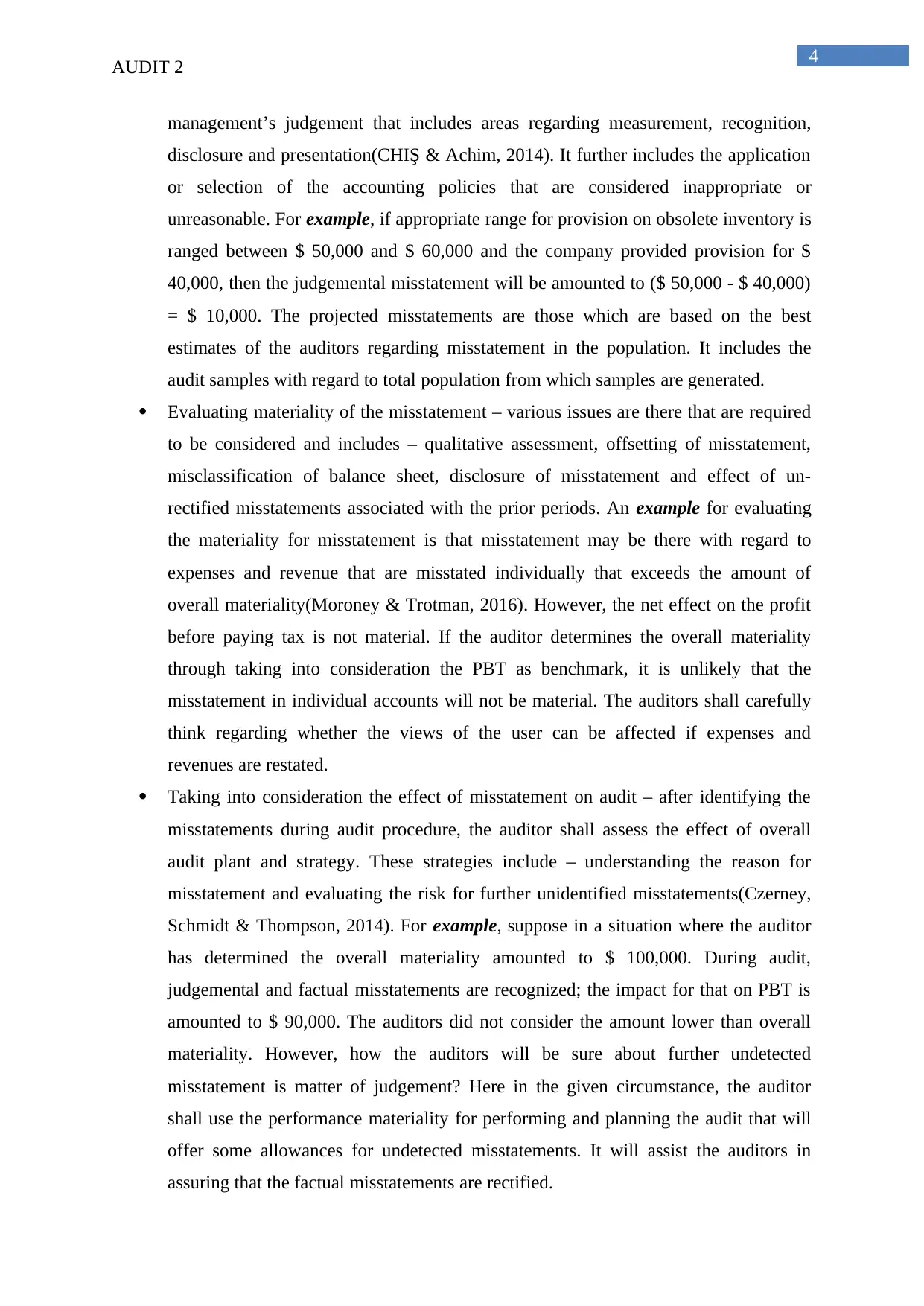
4
AUDIT 2
management’s judgement that includes areas regarding measurement, recognition,
disclosure and presentation(CHIŞ & Achim, 2014). It further includes the application
or selection of the accounting policies that are considered inappropriate or
unreasonable. For example, if appropriate range for provision on obsolete inventory is
ranged between $ 50,000 and $ 60,000 and the company provided provision for $
40,000, then the judgemental misstatement will be amounted to ($ 50,000 - $ 40,000)
= $ 10,000. The projected misstatements are those which are based on the best
estimates of the auditors regarding misstatement in the population. It includes the
audit samples with regard to total population from which samples are generated.
Evaluating materiality of the misstatement – various issues are there that are required
to be considered and includes – qualitative assessment, offsetting of misstatement,
misclassification of balance sheet, disclosure of misstatement and effect of un-
rectified misstatements associated with the prior periods. An example for evaluating
the materiality for misstatement is that misstatement may be there with regard to
expenses and revenue that are misstated individually that exceeds the amount of
overall materiality(Moroney & Trotman, 2016). However, the net effect on the profit
before paying tax is not material. If the auditor determines the overall materiality
through taking into consideration the PBT as benchmark, it is unlikely that the
misstatement in individual accounts will not be material. The auditors shall carefully
think regarding whether the views of the user can be affected if expenses and
revenues are restated.
Taking into consideration the effect of misstatement on audit – after identifying the
misstatements during audit procedure, the auditor shall assess the effect of overall
audit plant and strategy. These strategies include – understanding the reason for
misstatement and evaluating the risk for further unidentified misstatements(Czerney,
Schmidt & Thompson, 2014). For example, suppose in a situation where the auditor
has determined the overall materiality amounted to $ 100,000. During audit,
judgemental and factual misstatements are recognized; the impact for that on PBT is
amounted to $ 90,000. The auditors did not consider the amount lower than overall
materiality. However, how the auditors will be sure about further undetected
misstatement is matter of judgement? Here in the given circumstance, the auditor
shall use the performance materiality for performing and planning the audit that will
offer some allowances for undetected misstatements. It will assist the auditors in
assuring that the factual misstatements are rectified.
AUDIT 2
management’s judgement that includes areas regarding measurement, recognition,
disclosure and presentation(CHIŞ & Achim, 2014). It further includes the application
or selection of the accounting policies that are considered inappropriate or
unreasonable. For example, if appropriate range for provision on obsolete inventory is
ranged between $ 50,000 and $ 60,000 and the company provided provision for $
40,000, then the judgemental misstatement will be amounted to ($ 50,000 - $ 40,000)
= $ 10,000. The projected misstatements are those which are based on the best
estimates of the auditors regarding misstatement in the population. It includes the
audit samples with regard to total population from which samples are generated.
Evaluating materiality of the misstatement – various issues are there that are required
to be considered and includes – qualitative assessment, offsetting of misstatement,
misclassification of balance sheet, disclosure of misstatement and effect of un-
rectified misstatements associated with the prior periods. An example for evaluating
the materiality for misstatement is that misstatement may be there with regard to
expenses and revenue that are misstated individually that exceeds the amount of
overall materiality(Moroney & Trotman, 2016). However, the net effect on the profit
before paying tax is not material. If the auditor determines the overall materiality
through taking into consideration the PBT as benchmark, it is unlikely that the
misstatement in individual accounts will not be material. The auditors shall carefully
think regarding whether the views of the user can be affected if expenses and
revenues are restated.
Taking into consideration the effect of misstatement on audit – after identifying the
misstatements during audit procedure, the auditor shall assess the effect of overall
audit plant and strategy. These strategies include – understanding the reason for
misstatement and evaluating the risk for further unidentified misstatements(Czerney,
Schmidt & Thompson, 2014). For example, suppose in a situation where the auditor
has determined the overall materiality amounted to $ 100,000. During audit,
judgemental and factual misstatements are recognized; the impact for that on PBT is
amounted to $ 90,000. The auditors did not consider the amount lower than overall
materiality. However, how the auditors will be sure about further undetected
misstatement is matter of judgement? Here in the given circumstance, the auditor
shall use the performance materiality for performing and planning the audit that will
offer some allowances for undetected misstatements. It will assist the auditors in
assuring that the factual misstatements are rectified.
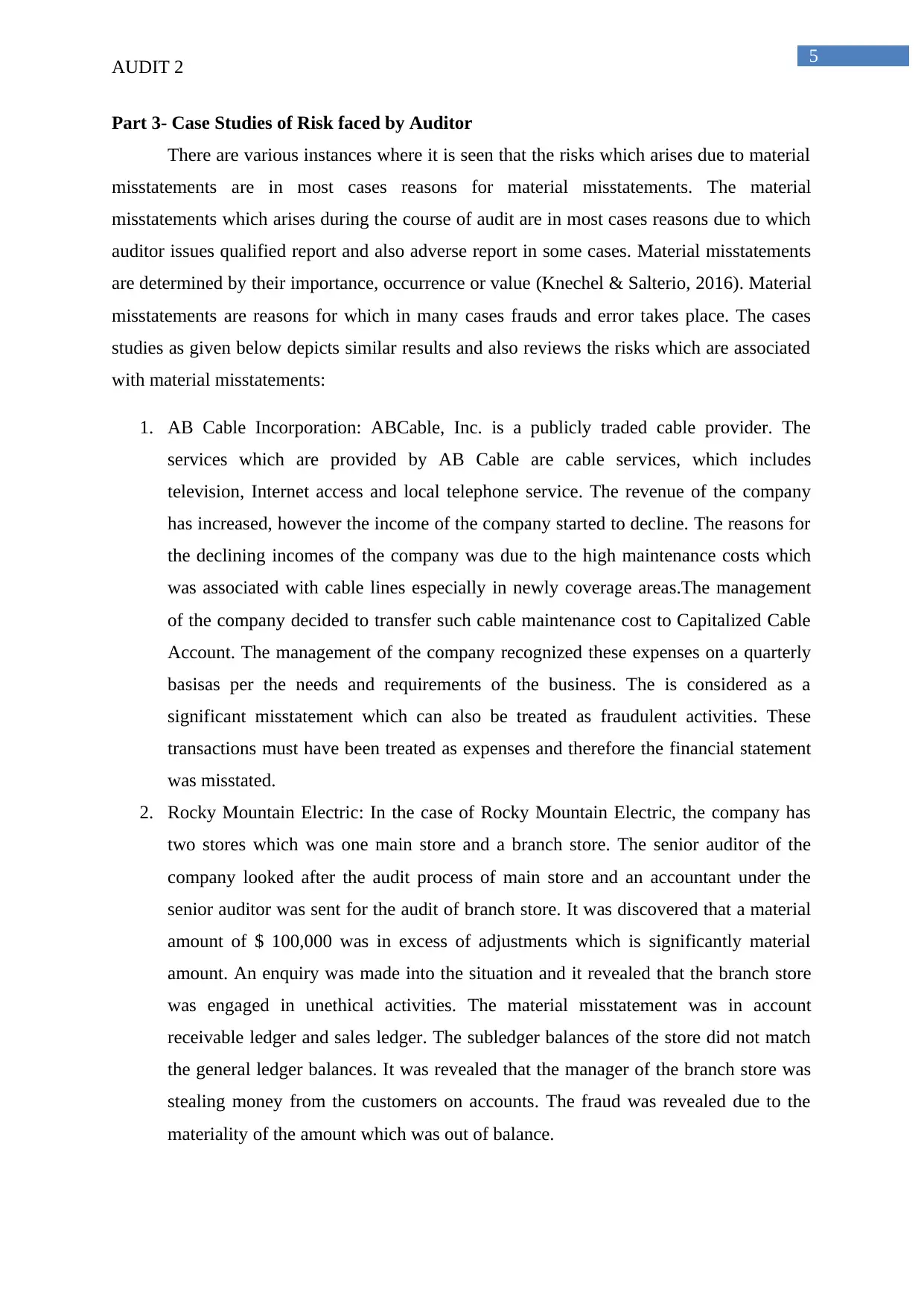
5
AUDIT 2
Part 3- Case Studies of Risk faced by Auditor
There are various instances where it is seen that the risks which arises due to material
misstatements are in most cases reasons for material misstatements. The material
misstatements which arises during the course of audit are in most cases reasons due to which
auditor issues qualified report and also adverse report in some cases. Material misstatements
are determined by their importance, occurrence or value (Knechel & Salterio, 2016). Material
misstatements are reasons for which in many cases frauds and error takes place. The cases
studies as given below depicts similar results and also reviews the risks which are associated
with material misstatements:
1. AB Cable Incorporation: ABCable, Inc. is a publicly traded cable provider. The
services which are provided by AB Cable are cable services, which includes
television, Internet access and local telephone service. The revenue of the company
has increased, however the income of the company started to decline. The reasons for
the declining incomes of the company was due to the high maintenance costs which
was associated with cable lines especially in newly coverage areas.The management
of the company decided to transfer such cable maintenance cost to Capitalized Cable
Account. The management of the company recognized these expenses on a quarterly
basisas per the needs and requirements of the business. The is considered as a
significant misstatement which can also be treated as fraudulent activities. These
transactions must have been treated as expenses and therefore the financial statement
was misstated.
2. Rocky Mountain Electric: In the case of Rocky Mountain Electric, the company has
two stores which was one main store and a branch store. The senior auditor of the
company looked after the audit process of main store and an accountant under the
senior auditor was sent for the audit of branch store. It was discovered that a material
amount of $ 100,000 was in excess of adjustments which is significantly material
amount. An enquiry was made into the situation and it revealed that the branch store
was engaged in unethical activities. The material misstatement was in account
receivable ledger and sales ledger. The subledger balances of the store did not match
the general ledger balances. It was revealed that the manager of the branch store was
stealing money from the customers on accounts. The fraud was revealed due to the
materiality of the amount which was out of balance.
AUDIT 2
Part 3- Case Studies of Risk faced by Auditor
There are various instances where it is seen that the risks which arises due to material
misstatements are in most cases reasons for material misstatements. The material
misstatements which arises during the course of audit are in most cases reasons due to which
auditor issues qualified report and also adverse report in some cases. Material misstatements
are determined by their importance, occurrence or value (Knechel & Salterio, 2016). Material
misstatements are reasons for which in many cases frauds and error takes place. The cases
studies as given below depicts similar results and also reviews the risks which are associated
with material misstatements:
1. AB Cable Incorporation: ABCable, Inc. is a publicly traded cable provider. The
services which are provided by AB Cable are cable services, which includes
television, Internet access and local telephone service. The revenue of the company
has increased, however the income of the company started to decline. The reasons for
the declining incomes of the company was due to the high maintenance costs which
was associated with cable lines especially in newly coverage areas.The management
of the company decided to transfer such cable maintenance cost to Capitalized Cable
Account. The management of the company recognized these expenses on a quarterly
basisas per the needs and requirements of the business. The is considered as a
significant misstatement which can also be treated as fraudulent activities. These
transactions must have been treated as expenses and therefore the financial statement
was misstated.
2. Rocky Mountain Electric: In the case of Rocky Mountain Electric, the company has
two stores which was one main store and a branch store. The senior auditor of the
company looked after the audit process of main store and an accountant under the
senior auditor was sent for the audit of branch store. It was discovered that a material
amount of $ 100,000 was in excess of adjustments which is significantly material
amount. An enquiry was made into the situation and it revealed that the branch store
was engaged in unethical activities. The material misstatement was in account
receivable ledger and sales ledger. The subledger balances of the store did not match
the general ledger balances. It was revealed that the manager of the branch store was
stealing money from the customers on accounts. The fraud was revealed due to the
materiality of the amount which was out of balance.
⊘ This is a preview!⊘
Do you want full access?
Subscribe today to unlock all pages.

Trusted by 1+ million students worldwide
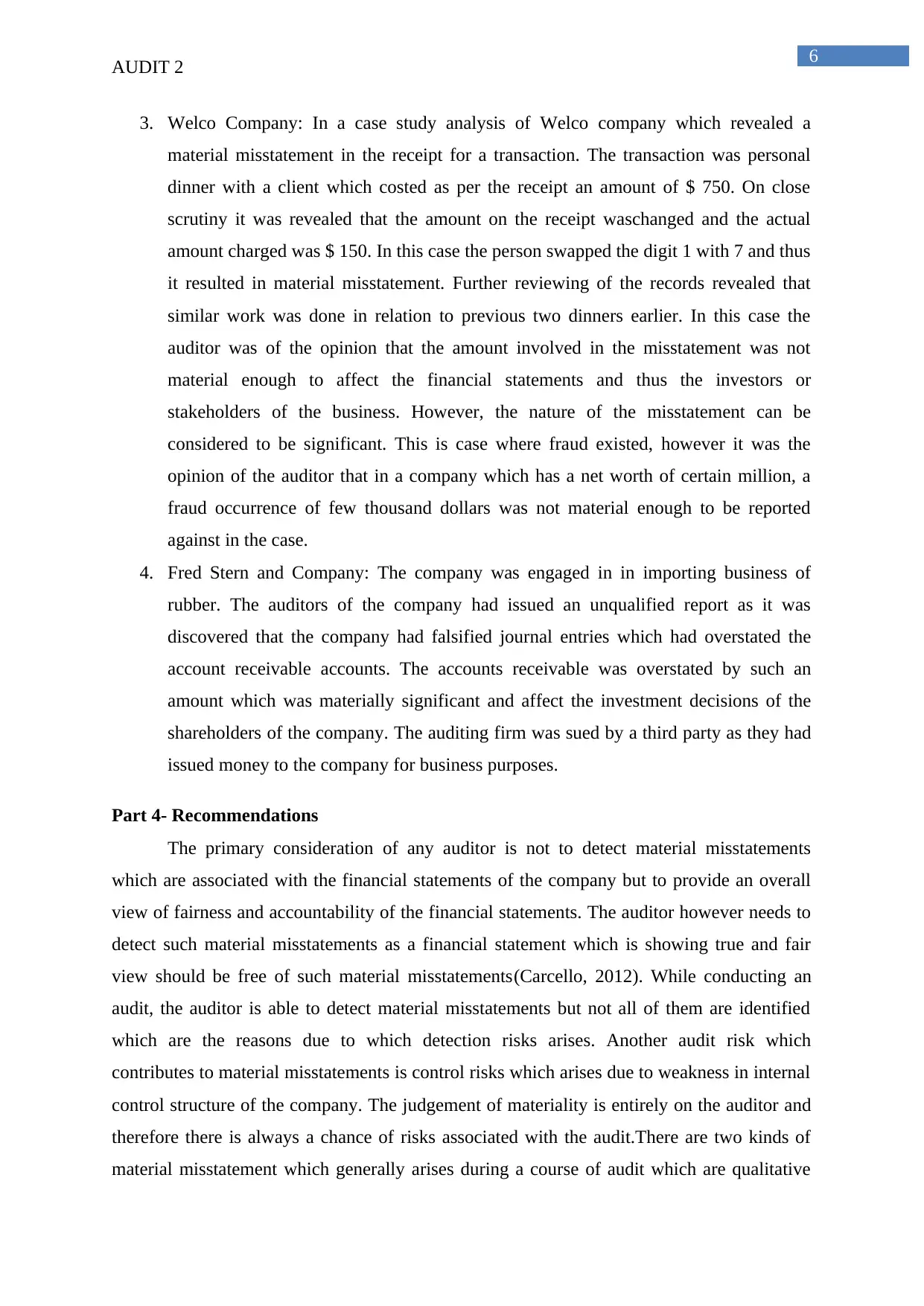
6
AUDIT 2
3. Welco Company: In a case study analysis of Welco company which revealed a
material misstatement in the receipt for a transaction. The transaction was personal
dinner with a client which costed as per the receipt an amount of $ 750. On close
scrutiny it was revealed that the amount on the receipt waschanged and the actual
amount charged was $ 150. In this case the person swapped the digit 1 with 7 and thus
it resulted in material misstatement. Further reviewing of the records revealed that
similar work was done in relation to previous two dinners earlier. In this case the
auditor was of the opinion that the amount involved in the misstatement was not
material enough to affect the financial statements and thus the investors or
stakeholders of the business. However, the nature of the misstatement can be
considered to be significant. This is case where fraud existed, however it was the
opinion of the auditor that in a company which has a net worth of certain million, a
fraud occurrence of few thousand dollars was not material enough to be reported
against in the case.
4. Fred Stern and Company: The company was engaged in in importing business of
rubber. The auditors of the company had issued an unqualified report as it was
discovered that the company had falsified journal entries which had overstated the
account receivable accounts. The accounts receivable was overstated by such an
amount which was materially significant and affect the investment decisions of the
shareholders of the company. The auditing firm was sued by a third party as they had
issued money to the company for business purposes.
Part 4- Recommendations
The primary consideration of any auditor is not to detect material misstatements
which are associated with the financial statements of the company but to provide an overall
view of fairness and accountability of the financial statements. The auditor however needs to
detect such material misstatements as a financial statement which is showing true and fair
view should be free of such material misstatements(Carcello, 2012). While conducting an
audit, the auditor is able to detect material misstatements but not all of them are identified
which are the reasons due to which detection risks arises. Another audit risk which
contributes to material misstatements is control risks which arises due to weakness in internal
control structure of the company. The judgement of materiality is entirely on the auditor and
therefore there is always a chance of risks associated with the audit.There are two kinds of
material misstatement which generally arises during a course of audit which are qualitative
AUDIT 2
3. Welco Company: In a case study analysis of Welco company which revealed a
material misstatement in the receipt for a transaction. The transaction was personal
dinner with a client which costed as per the receipt an amount of $ 750. On close
scrutiny it was revealed that the amount on the receipt waschanged and the actual
amount charged was $ 150. In this case the person swapped the digit 1 with 7 and thus
it resulted in material misstatement. Further reviewing of the records revealed that
similar work was done in relation to previous two dinners earlier. In this case the
auditor was of the opinion that the amount involved in the misstatement was not
material enough to affect the financial statements and thus the investors or
stakeholders of the business. However, the nature of the misstatement can be
considered to be significant. This is case where fraud existed, however it was the
opinion of the auditor that in a company which has a net worth of certain million, a
fraud occurrence of few thousand dollars was not material enough to be reported
against in the case.
4. Fred Stern and Company: The company was engaged in in importing business of
rubber. The auditors of the company had issued an unqualified report as it was
discovered that the company had falsified journal entries which had overstated the
account receivable accounts. The accounts receivable was overstated by such an
amount which was materially significant and affect the investment decisions of the
shareholders of the company. The auditing firm was sued by a third party as they had
issued money to the company for business purposes.
Part 4- Recommendations
The primary consideration of any auditor is not to detect material misstatements
which are associated with the financial statements of the company but to provide an overall
view of fairness and accountability of the financial statements. The auditor however needs to
detect such material misstatements as a financial statement which is showing true and fair
view should be free of such material misstatements(Carcello, 2012). While conducting an
audit, the auditor is able to detect material misstatements but not all of them are identified
which are the reasons due to which detection risks arises. Another audit risk which
contributes to material misstatements is control risks which arises due to weakness in internal
control structure of the company. The judgement of materiality is entirely on the auditor and
therefore there is always a chance of risks associated with the audit.There are two kinds of
material misstatement which generally arises during a course of audit which are qualitative
Paraphrase This Document
Need a fresh take? Get an instant paraphrase of this document with our AI Paraphraser
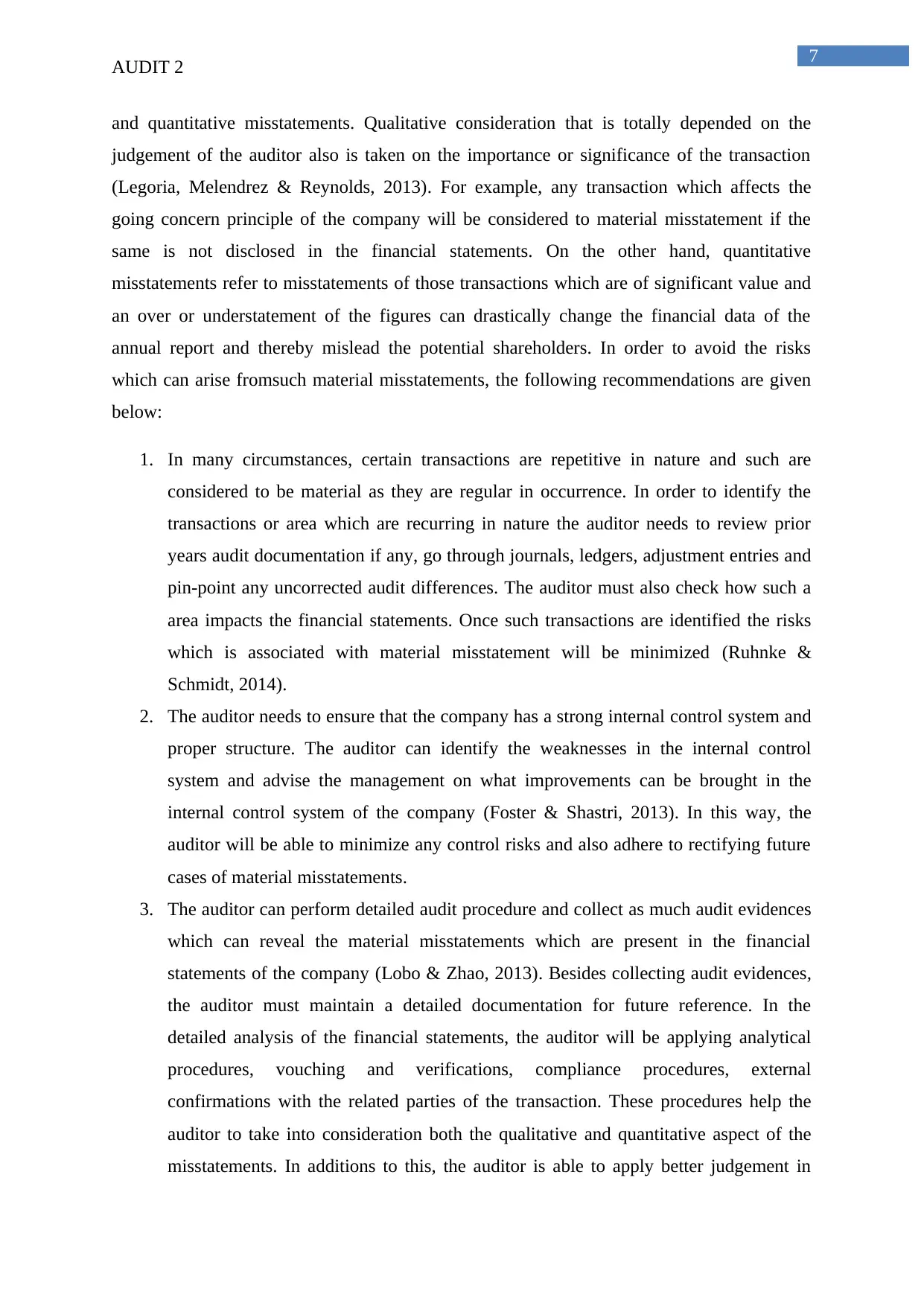
7
AUDIT 2
and quantitative misstatements. Qualitative consideration that is totally depended on the
judgement of the auditor also is taken on the importance or significance of the transaction
(Legoria, Melendrez & Reynolds, 2013). For example, any transaction which affects the
going concern principle of the company will be considered to material misstatement if the
same is not disclosed in the financial statements. On the other hand, quantitative
misstatements refer to misstatements of those transactions which are of significant value and
an over or understatement of the figures can drastically change the financial data of the
annual report and thereby mislead the potential shareholders. In order to avoid the risks
which can arise fromsuch material misstatements, the following recommendations are given
below:
1. In many circumstances, certain transactions are repetitive in nature and such are
considered to be material as they are regular in occurrence. In order to identify the
transactions or area which are recurring in nature the auditor needs to review prior
years audit documentation if any, go through journals, ledgers, adjustment entries and
pin-point any uncorrected audit differences. The auditor must also check how such a
area impacts the financial statements. Once such transactions are identified the risks
which is associated with material misstatement will be minimized (Ruhnke &
Schmidt, 2014).
2. The auditor needs to ensure that the company has a strong internal control system and
proper structure. The auditor can identify the weaknesses in the internal control
system and advise the management on what improvements can be brought in the
internal control system of the company (Foster & Shastri, 2013). In this way, the
auditor will be able to minimize any control risks and also adhere to rectifying future
cases of material misstatements.
3. The auditor can perform detailed audit procedure and collect as much audit evidences
which can reveal the material misstatements which are present in the financial
statements of the company (Lobo & Zhao, 2013). Besides collecting audit evidences,
the auditor must maintain a detailed documentation for future reference. In the
detailed analysis of the financial statements, the auditor will be applying analytical
procedures, vouching and verifications, compliance procedures, external
confirmations with the related parties of the transaction. These procedures help the
auditor to take into consideration both the qualitative and quantitative aspect of the
misstatements. In additions to this, the auditor is able to apply better judgement in
AUDIT 2
and quantitative misstatements. Qualitative consideration that is totally depended on the
judgement of the auditor also is taken on the importance or significance of the transaction
(Legoria, Melendrez & Reynolds, 2013). For example, any transaction which affects the
going concern principle of the company will be considered to material misstatement if the
same is not disclosed in the financial statements. On the other hand, quantitative
misstatements refer to misstatements of those transactions which are of significant value and
an over or understatement of the figures can drastically change the financial data of the
annual report and thereby mislead the potential shareholders. In order to avoid the risks
which can arise fromsuch material misstatements, the following recommendations are given
below:
1. In many circumstances, certain transactions are repetitive in nature and such are
considered to be material as they are regular in occurrence. In order to identify the
transactions or area which are recurring in nature the auditor needs to review prior
years audit documentation if any, go through journals, ledgers, adjustment entries and
pin-point any uncorrected audit differences. The auditor must also check how such a
area impacts the financial statements. Once such transactions are identified the risks
which is associated with material misstatement will be minimized (Ruhnke &
Schmidt, 2014).
2. The auditor needs to ensure that the company has a strong internal control system and
proper structure. The auditor can identify the weaknesses in the internal control
system and advise the management on what improvements can be brought in the
internal control system of the company (Foster & Shastri, 2013). In this way, the
auditor will be able to minimize any control risks and also adhere to rectifying future
cases of material misstatements.
3. The auditor can perform detailed audit procedure and collect as much audit evidences
which can reveal the material misstatements which are present in the financial
statements of the company (Lobo & Zhao, 2013). Besides collecting audit evidences,
the auditor must maintain a detailed documentation for future reference. In the
detailed analysis of the financial statements, the auditor will be applying analytical
procedures, vouching and verifications, compliance procedures, external
confirmations with the related parties of the transaction. These procedures help the
auditor to take into consideration both the qualitative and quantitative aspect of the
misstatements. In additions to this, the auditor is able to apply better judgement in
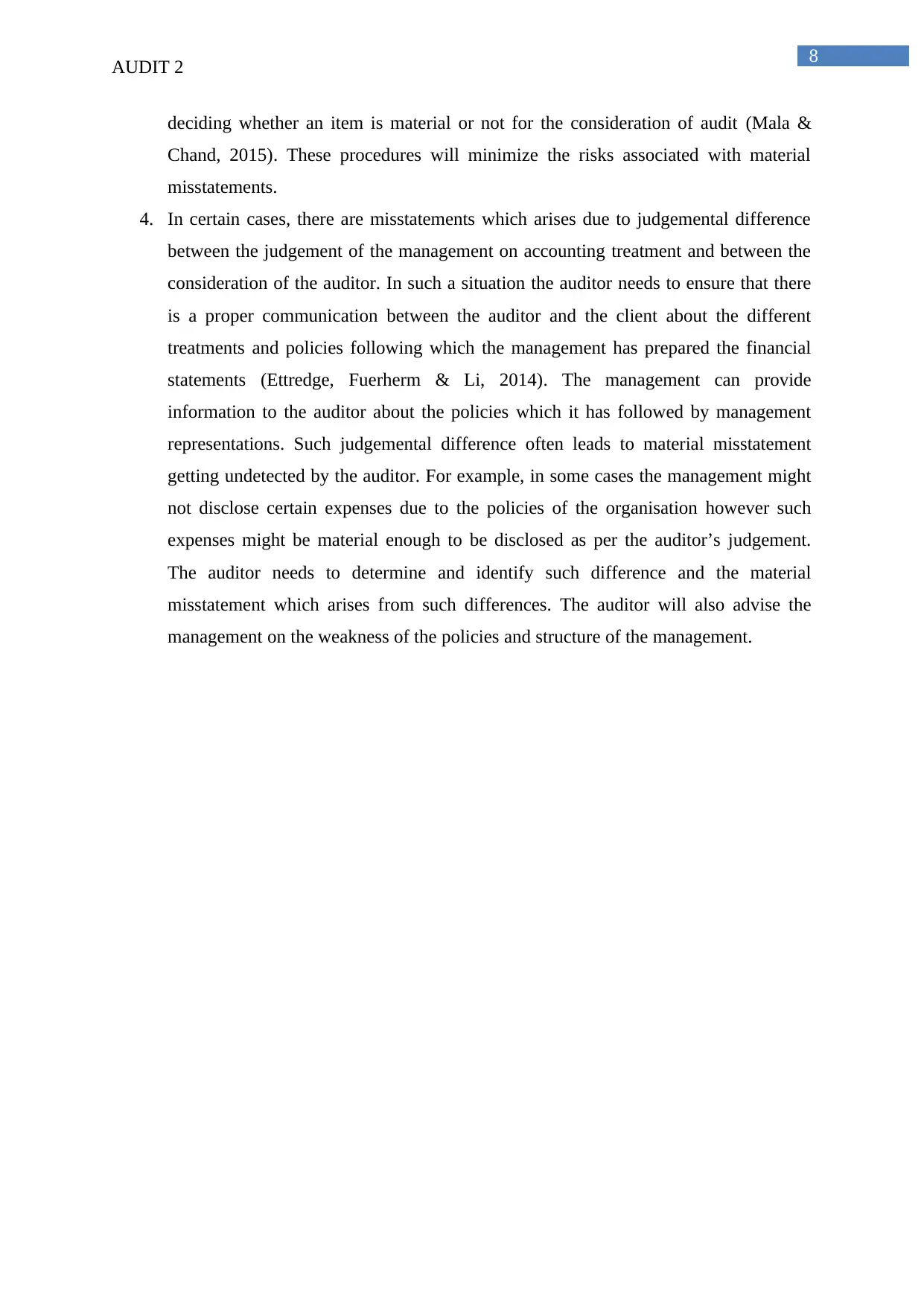
8
AUDIT 2
deciding whether an item is material or not for the consideration of audit (Mala &
Chand, 2015). These procedures will minimize the risks associated with material
misstatements.
4. In certain cases, there are misstatements which arises due to judgemental difference
between the judgement of the management on accounting treatment and between the
consideration of the auditor. In such a situation the auditor needs to ensure that there
is a proper communication between the auditor and the client about the different
treatments and policies following which the management has prepared the financial
statements (Ettredge, Fuerherm & Li, 2014). The management can provide
information to the auditor about the policies which it has followed by management
representations. Such judgemental difference often leads to material misstatement
getting undetected by the auditor. For example, in some cases the management might
not disclose certain expenses due to the policies of the organisation however such
expenses might be material enough to be disclosed as per the auditor’s judgement.
The auditor needs to determine and identify such difference and the material
misstatement which arises from such differences. The auditor will also advise the
management on the weakness of the policies and structure of the management.
AUDIT 2
deciding whether an item is material or not for the consideration of audit (Mala &
Chand, 2015). These procedures will minimize the risks associated with material
misstatements.
4. In certain cases, there are misstatements which arises due to judgemental difference
between the judgement of the management on accounting treatment and between the
consideration of the auditor. In such a situation the auditor needs to ensure that there
is a proper communication between the auditor and the client about the different
treatments and policies following which the management has prepared the financial
statements (Ettredge, Fuerherm & Li, 2014). The management can provide
information to the auditor about the policies which it has followed by management
representations. Such judgemental difference often leads to material misstatement
getting undetected by the auditor. For example, in some cases the management might
not disclose certain expenses due to the policies of the organisation however such
expenses might be material enough to be disclosed as per the auditor’s judgement.
The auditor needs to determine and identify such difference and the material
misstatement which arises from such differences. The auditor will also advise the
management on the weakness of the policies and structure of the management.
⊘ This is a preview!⊘
Do you want full access?
Subscribe today to unlock all pages.

Trusted by 1+ million students worldwide
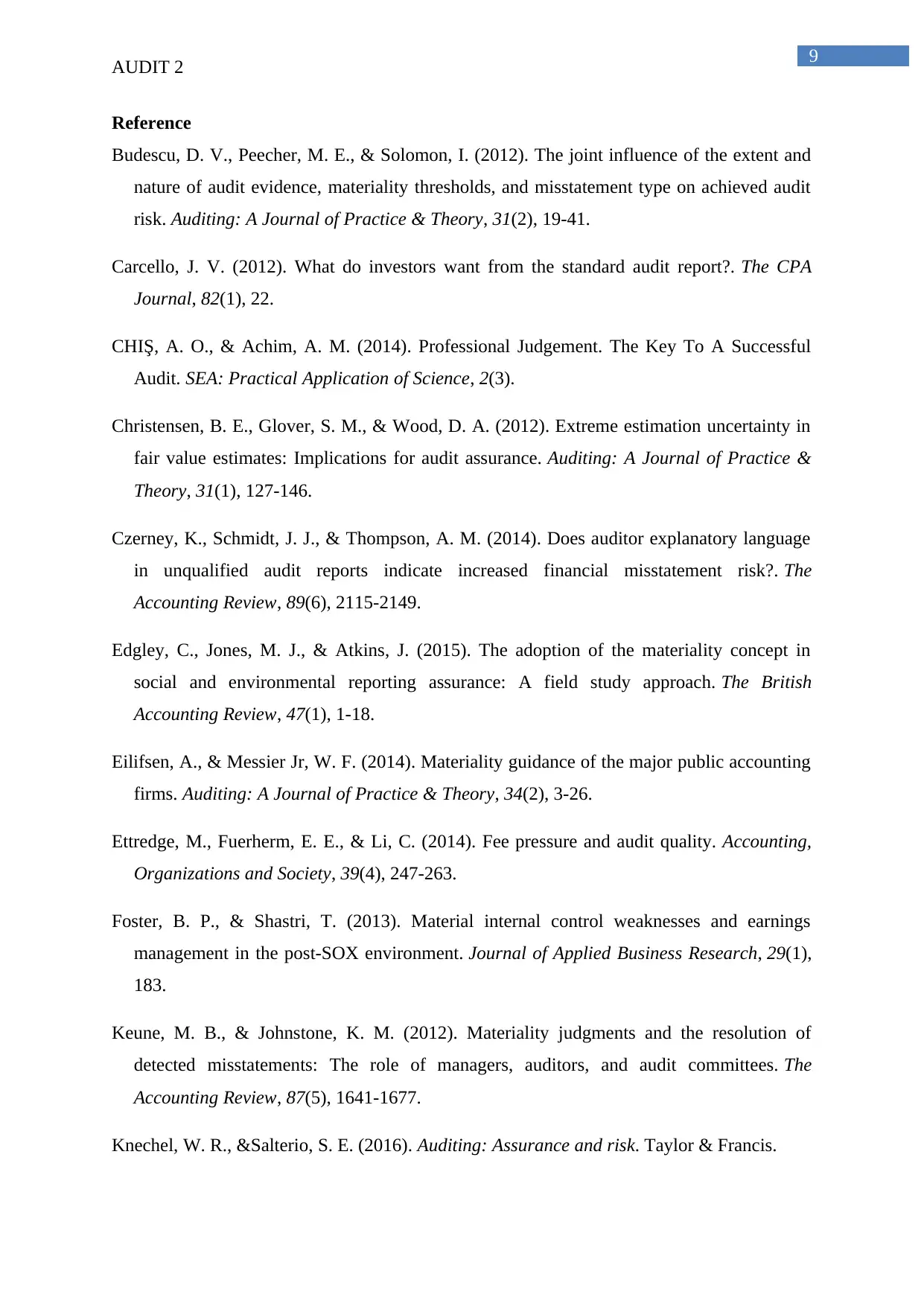
9
AUDIT 2
Reference
Budescu, D. V., Peecher, M. E., & Solomon, I. (2012). The joint influence of the extent and
nature of audit evidence, materiality thresholds, and misstatement type on achieved audit
risk. Auditing: A Journal of Practice & Theory, 31(2), 19-41.
Carcello, J. V. (2012). What do investors want from the standard audit report?. The CPA
Journal, 82(1), 22.
CHIŞ, A. O., & Achim, A. M. (2014). Professional Judgement. The Key To A Successful
Audit. SEA: Practical Application of Science, 2(3).
Christensen, B. E., Glover, S. M., & Wood, D. A. (2012). Extreme estimation uncertainty in
fair value estimates: Implications for audit assurance. Auditing: A Journal of Practice &
Theory, 31(1), 127-146.
Czerney, K., Schmidt, J. J., & Thompson, A. M. (2014). Does auditor explanatory language
in unqualified audit reports indicate increased financial misstatement risk?. The
Accounting Review, 89(6), 2115-2149.
Edgley, C., Jones, M. J., & Atkins, J. (2015). The adoption of the materiality concept in
social and environmental reporting assurance: A field study approach. The British
Accounting Review, 47(1), 1-18.
Eilifsen, A., & Messier Jr, W. F. (2014). Materiality guidance of the major public accounting
firms. Auditing: A Journal of Practice & Theory, 34(2), 3-26.
Ettredge, M., Fuerherm, E. E., & Li, C. (2014). Fee pressure and audit quality. Accounting,
Organizations and Society, 39(4), 247-263.
Foster, B. P., & Shastri, T. (2013). Material internal control weaknesses and earnings
management in the post-SOX environment. Journal of Applied Business Research, 29(1),
183.
Keune, M. B., & Johnstone, K. M. (2012). Materiality judgments and the resolution of
detected misstatements: The role of managers, auditors, and audit committees. The
Accounting Review, 87(5), 1641-1677.
Knechel, W. R., &Salterio, S. E. (2016). Auditing: Assurance and risk. Taylor & Francis.
AUDIT 2
Reference
Budescu, D. V., Peecher, M. E., & Solomon, I. (2012). The joint influence of the extent and
nature of audit evidence, materiality thresholds, and misstatement type on achieved audit
risk. Auditing: A Journal of Practice & Theory, 31(2), 19-41.
Carcello, J. V. (2012). What do investors want from the standard audit report?. The CPA
Journal, 82(1), 22.
CHIŞ, A. O., & Achim, A. M. (2014). Professional Judgement. The Key To A Successful
Audit. SEA: Practical Application of Science, 2(3).
Christensen, B. E., Glover, S. M., & Wood, D. A. (2012). Extreme estimation uncertainty in
fair value estimates: Implications for audit assurance. Auditing: A Journal of Practice &
Theory, 31(1), 127-146.
Czerney, K., Schmidt, J. J., & Thompson, A. M. (2014). Does auditor explanatory language
in unqualified audit reports indicate increased financial misstatement risk?. The
Accounting Review, 89(6), 2115-2149.
Edgley, C., Jones, M. J., & Atkins, J. (2015). The adoption of the materiality concept in
social and environmental reporting assurance: A field study approach. The British
Accounting Review, 47(1), 1-18.
Eilifsen, A., & Messier Jr, W. F. (2014). Materiality guidance of the major public accounting
firms. Auditing: A Journal of Practice & Theory, 34(2), 3-26.
Ettredge, M., Fuerherm, E. E., & Li, C. (2014). Fee pressure and audit quality. Accounting,
Organizations and Society, 39(4), 247-263.
Foster, B. P., & Shastri, T. (2013). Material internal control weaknesses and earnings
management in the post-SOX environment. Journal of Applied Business Research, 29(1),
183.
Keune, M. B., & Johnstone, K. M. (2012). Materiality judgments and the resolution of
detected misstatements: The role of managers, auditors, and audit committees. The
Accounting Review, 87(5), 1641-1677.
Knechel, W. R., &Salterio, S. E. (2016). Auditing: Assurance and risk. Taylor & Francis.
Paraphrase This Document
Need a fresh take? Get an instant paraphrase of this document with our AI Paraphraser
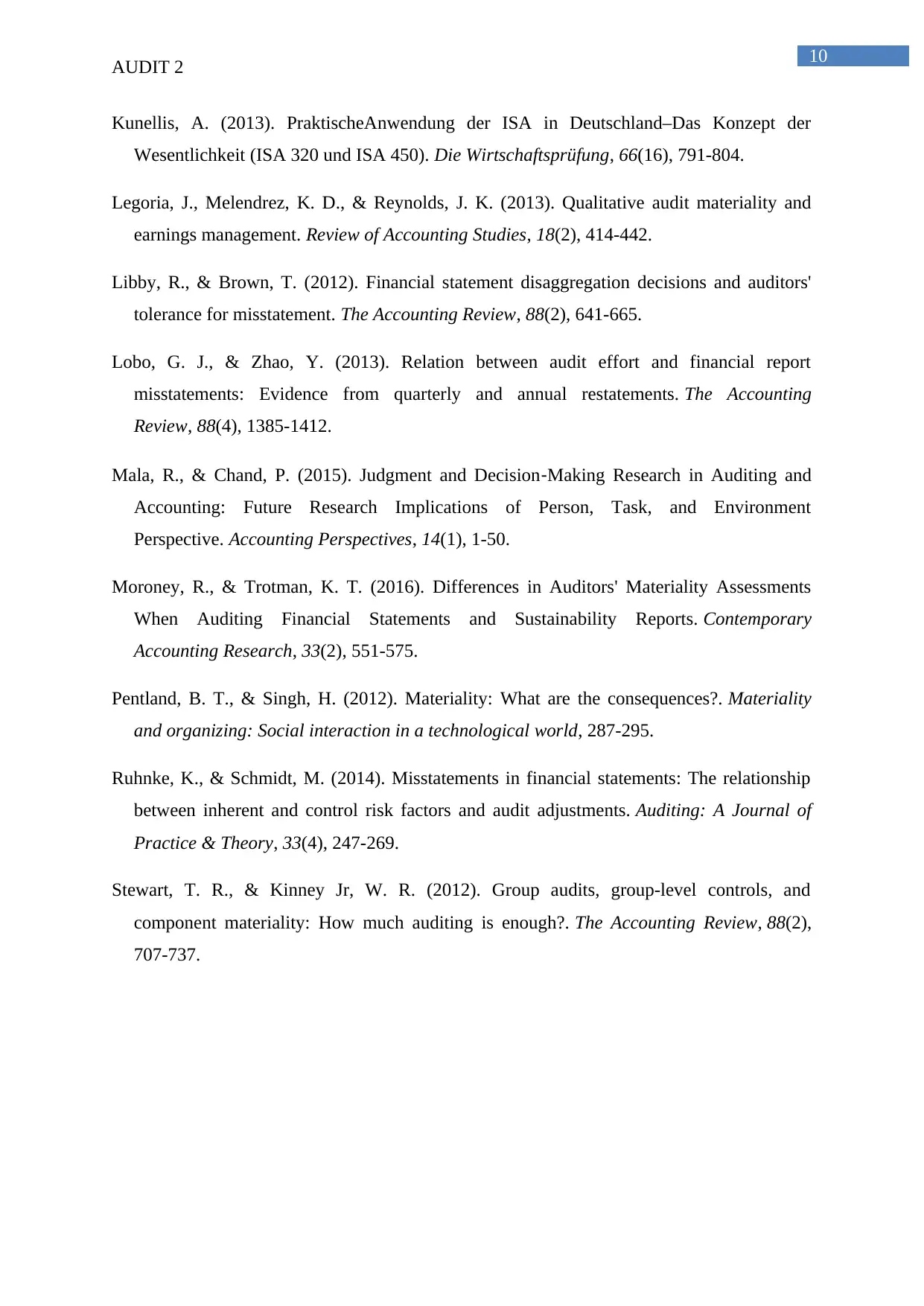
10
AUDIT 2
Kunellis, A. (2013). PraktischeAnwendung der ISA in Deutschland–Das Konzept der
Wesentlichkeit (ISA 320 und ISA 450). Die Wirtschaftsprüfung, 66(16), 791-804.
Legoria, J., Melendrez, K. D., & Reynolds, J. K. (2013). Qualitative audit materiality and
earnings management. Review of Accounting Studies, 18(2), 414-442.
Libby, R., & Brown, T. (2012). Financial statement disaggregation decisions and auditors'
tolerance for misstatement. The Accounting Review, 88(2), 641-665.
Lobo, G. J., & Zhao, Y. (2013). Relation between audit effort and financial report
misstatements: Evidence from quarterly and annual restatements. The Accounting
Review, 88(4), 1385-1412.
Mala, R., & Chand, P. (2015). Judgment and Decision‐Making Research in Auditing and
Accounting: Future Research Implications of Person, Task, and Environment
Perspective. Accounting Perspectives, 14(1), 1-50.
Moroney, R., & Trotman, K. T. (2016). Differences in Auditors' Materiality Assessments
When Auditing Financial Statements and Sustainability Reports. Contemporary
Accounting Research, 33(2), 551-575.
Pentland, B. T., & Singh, H. (2012). Materiality: What are the consequences?. Materiality
and organizing: Social interaction in a technological world, 287-295.
Ruhnke, K., & Schmidt, M. (2014). Misstatements in financial statements: The relationship
between inherent and control risk factors and audit adjustments. Auditing: A Journal of
Practice & Theory, 33(4), 247-269.
Stewart, T. R., & Kinney Jr, W. R. (2012). Group audits, group-level controls, and
component materiality: How much auditing is enough?. The Accounting Review, 88(2),
707-737.
AUDIT 2
Kunellis, A. (2013). PraktischeAnwendung der ISA in Deutschland–Das Konzept der
Wesentlichkeit (ISA 320 und ISA 450). Die Wirtschaftsprüfung, 66(16), 791-804.
Legoria, J., Melendrez, K. D., & Reynolds, J. K. (2013). Qualitative audit materiality and
earnings management. Review of Accounting Studies, 18(2), 414-442.
Libby, R., & Brown, T. (2012). Financial statement disaggregation decisions and auditors'
tolerance for misstatement. The Accounting Review, 88(2), 641-665.
Lobo, G. J., & Zhao, Y. (2013). Relation between audit effort and financial report
misstatements: Evidence from quarterly and annual restatements. The Accounting
Review, 88(4), 1385-1412.
Mala, R., & Chand, P. (2015). Judgment and Decision‐Making Research in Auditing and
Accounting: Future Research Implications of Person, Task, and Environment
Perspective. Accounting Perspectives, 14(1), 1-50.
Moroney, R., & Trotman, K. T. (2016). Differences in Auditors' Materiality Assessments
When Auditing Financial Statements and Sustainability Reports. Contemporary
Accounting Research, 33(2), 551-575.
Pentland, B. T., & Singh, H. (2012). Materiality: What are the consequences?. Materiality
and organizing: Social interaction in a technological world, 287-295.
Ruhnke, K., & Schmidt, M. (2014). Misstatements in financial statements: The relationship
between inherent and control risk factors and audit adjustments. Auditing: A Journal of
Practice & Theory, 33(4), 247-269.
Stewart, T. R., & Kinney Jr, W. R. (2012). Group audits, group-level controls, and
component materiality: How much auditing is enough?. The Accounting Review, 88(2),
707-737.

11
AUDIT 2
AUDIT 2
⊘ This is a preview!⊘
Do you want full access?
Subscribe today to unlock all pages.

Trusted by 1+ million students worldwide
1 out of 12
Related Documents
Your All-in-One AI-Powered Toolkit for Academic Success.
+13062052269
info@desklib.com
Available 24*7 on WhatsApp / Email
![[object Object]](/_next/static/media/star-bottom.7253800d.svg)
Unlock your academic potential
Copyright © 2020–2025 A2Z Services. All Rights Reserved. Developed and managed by ZUCOL.





